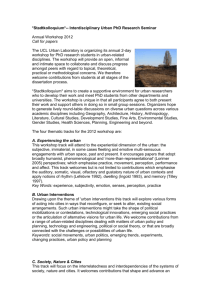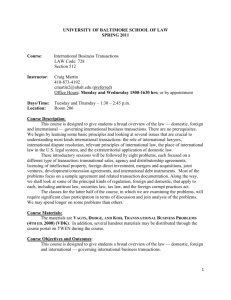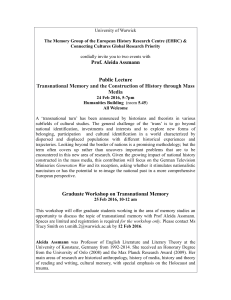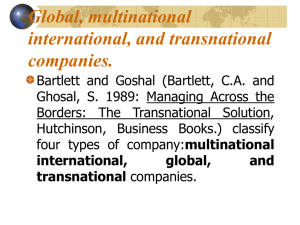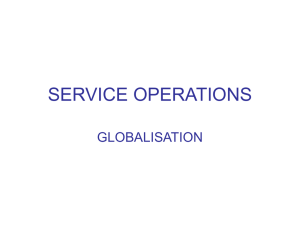Stoller and transnational fieldwork
advertisement
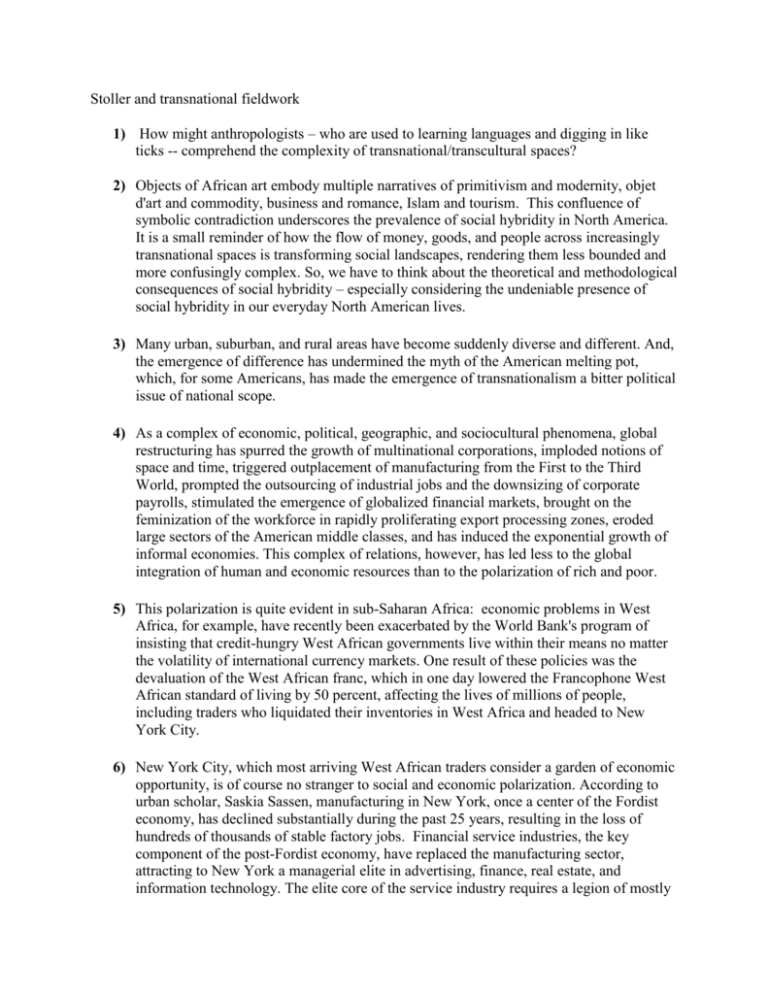
Stoller and transnational fieldwork 1) How might anthropologists – who are used to learning languages and digging in like ticks -- comprehend the complexity of transnational/transcultural spaces? 2) Objects of African art embody multiple narratives of primitivism and modernity, objet d'art and commodity, business and romance, Islam and tourism. This confluence of symbolic contradiction underscores the prevalence of social hybridity in North America. It is a small reminder of how the flow of money, goods, and people across increasingly transnational spaces is transforming social landscapes, rendering them less bounded and more confusingly complex. So, we have to think about the theoretical and methodological consequences of social hybridity – especially considering the undeniable presence of social hybridity in our everyday North American lives. 3) Many urban, suburban, and rural areas have become suddenly diverse and different. And, the emergence of difference has undermined the myth of the American melting pot, which, for some Americans, has made the emergence of transnationalism a bitter political issue of national scope. 4) As a complex of economic, political, geographic, and sociocultural phenomena, global restructuring has spurred the growth of multinational corporations, imploded notions of space and time, triggered outplacement of manufacturing from the First to the Third World, prompted the outsourcing of industrial jobs and the downsizing of corporate payrolls, stimulated the emergence of globalized financial markets, brought on the feminization of the workforce in rapidly proliferating export processing zones, eroded large sectors of the American middle classes, and has induced the exponential growth of informal economies. This complex of relations, however, has led less to the global integration of human and economic resources than to the polarization of rich and poor. 5) This polarization is quite evident in sub-Saharan Africa: economic problems in West Africa, for example, have recently been exacerbated by the World Bank's program of insisting that credit-hungry West African governments live within their means no matter the volatility of international currency markets. One result of these policies was the devaluation of the West African franc, which in one day lowered the Francophone West African standard of living by 50 percent, affecting the lives of millions of people, including traders who liquidated their inventories in West Africa and headed to New York City. 6) New York City, which most arriving West African traders consider a garden of economic opportunity, is of course no stranger to social and economic polarization. According to urban scholar, Saskia Sassen, manufacturing in New York, once a center of the Fordist economy, has declined substantially during the past 25 years, resulting in the loss of hundreds of thousands of stable factory jobs. Financial service industries, the key component of the post-Fordist economy, have replaced the manufacturing sector, attracting to New York a managerial elite in advertising, finance, real estate, and information technology. The elite core of the service industry requires a legion of mostly female clerical workers, most of whom work for low wages, little employment security, and limited health insurance. The forces that made New York what Saskia Sassen has called a “global city” have also provoked massive economic and spatial dislocation, creating a "dual city." The duality is between a comparatively cohesive "core" group of professionals who are "hooked up" to the global corporate economy and an ethnically and culturally diverse "periphery" that is increasingly unable to organize politically in order to influence the "core" upon which its limited forms of security depend. 7) The expansion of the gulf between rich and poor in New York City created space for the rapid growth of the informal economy – made not by the validity of the goods or services produced, the character of the labor force, or the site of production, but the fact that it is unregulated by the institutions of society, in a legal and social environment in which similar activities are regulated. 8) Many of the West Africans attracted by the global lights of New York City expected to earn decent wages in the formal sector. They did not come to New York, according to many of them, to settle, but to make as much money as possible and then return home—a very transnational conceit. After arriving, they soon found out that their lack of English, limited technological skills, and murky immigration status made working in the regulated economy almost impossible. 9) On fieldwork: The cultural and political realities of working among West African street vendors in Harlem changed the epistemological and existential contours of Stoller’s fieldwork. He no longer had the luxury – as when he worked on sorcery in the republic of Niger – of focusing on and contextualing one narrowly defined cultural element , but he had to embrace sociocultural complexity all at once. This shift meant that he needed to become thoroughly grounded in urban and immigration studies—economics, geography, sociology, and political science, as well as urban anthropology. He also had to adopt what he calls a “street-level approach.” There was no digging in like a tick. 10) Global restructuring has transformed many anthropological fields into transnational spaces. In transnational spaces the traditional concepts of culture, society, nation, and citizen are as anachronistic as the solitary anthropologist salvaging pristine knowledge. The fundamental transformation of space, place, and time requires more broadly-based research strategies, or what some have called a "globalizing method." In fact, what is needed is a multidisciplinary teams of scholars with different theoretical frameworks.


